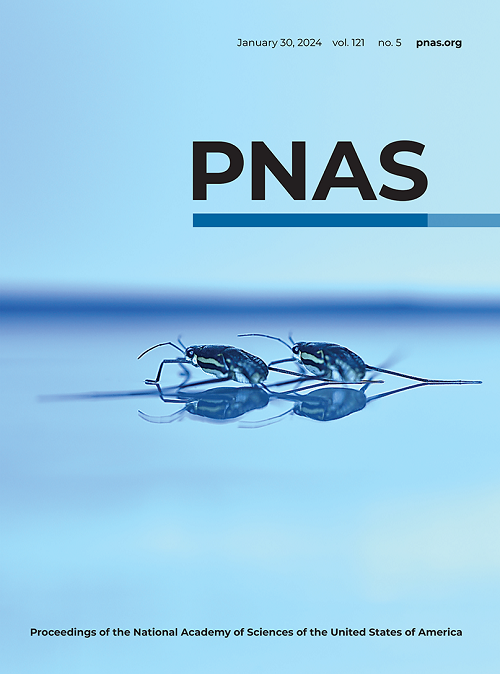非底物PI(4,5) p2与结构域间连接体相互作用以控制电压感应磷酸酶(VSP)中的电化学耦合。
IF 9.1
1区 综合性期刊
Q1 MULTIDISCIPLINARY SCIENCES
Proceedings of the National Academy of Sciences of the United States of America
Pub Date : 2025-07-29
DOI:10.1073/pnas.2500651122
引用次数: 0
摘要
电压感应磷酸酶(VSP)由电压传感器域(VSD)和细胞质催化区(CCR)组成,实现独特的电化学信号转换。先前的研究表明,磷脂酰肌醇4,5-二磷酸(PI(4,5) p2)是一种膜磷脂,已知对各种电压门控离子通道的活性至关重要,它与连接VSD和VSP的CCR的连接物相关,并调节VSD-CCR的偶联。然而,PI(4,5) p2与VSP连接子相互作用的细节仍然难以捉摸。本研究利用非天然荧光氨基酸3-(6-乙酰萘-2-氨基)-2-氨基丙酸(Anap)对局部环境变化的敏感性,研究了PI(4,5) p2与Ciona ninteinalis VSP (Ci-VSP)连接体之间的相互作用。我们发现一个保守的酪氨酸残基(Y255)以及邻近的碱基残基与PI(4,5) p2相互作用,并且这种相互作用在活性位点缺乏底物PI(4,5) p2的G365A Ci-VSP突变体和不使PI(4,5) p2去磷酸化的Ci-VSP/人磷酸酶和紧张素同源物(PTEN)嵌合体中得以维持,这表明该连接物与活性位点外的非底物、调控PI(4,5) p2相互作用。分子动力学模拟表明,在激活状态下,该连接子与PI(4,5) p2形成稳定的相互作用。这些发现表明,通过PI(4,5) p2结合到VSD下游的效应区对偶联的调节是电压依赖性膜蛋白共有的。本文章由计算机程序翻译,如有差异,请以英文原文为准。
Nonsubstrate PI(4,5)P 2 interacts with the interdomain linker to control electrochemical coupling in voltage-sensing phosphatase (VSP)
Voltage-sensing phosphatase (VSP) comprises a voltage sensor domain (VSD) and a cytoplasmic catalytic region (CCR), achieving a unique electrochemical signal conversion. Previous studies suggest that phosphatidylinositol 4,5-bisphosphate (PI(4,5)P 2 ), a membrane phospholipid known to be critical for activities of diverse voltage-gated ion channels, associates with a linker connecting the VSD with the CCR of VSP and regulates VSD-CCR coupling. However, the details of PI(4,5)P 2 interaction with the linker of VSP remain elusive. Here, we exploit advantage of sensitivity of a fluorescent unnatural amino acid, 3-(6-acetylnaphthalen-2-ylamino)-2-aminopropanoic acid (Anap), to changes in local environment to study interaction between PI(4,5)P 2 and the linker of Ciona intestinalis VSP (Ci-VSP). We found that a conserved tyrosine residue (Y255) as well as neighboring basic residues interacts with PI(4,5)P 2 and this interaction was maintained in G365A Ci-VSP mutant which lacks the substrate PI(4,5)P 2 at the active site and Ci-VSP/human phosphatase and tensin homolog (PTEN) chimera which does not dephosphorylate PI(4,5)P 2 , indicating that the linker interacts with nonsubstrate, regulatory PI(4,5)P 2 outside the active site. Molecular dynamics simulations demonstrated that the linker formed stable interaction with PI(4,5)P 2 in the activated state. These findings indicate that regulation of coupling to an effector region downstream of the VSD through PI(4,5)P 2 binding to the linker is shared among voltage-dependent membrane proteins.
求助全文
通过发布文献求助,成功后即可免费获取论文全文。
去求助
来源期刊
CiteScore
19.00
自引率
0.90%
发文量
3575
审稿时长
2.5 months
期刊介绍:
The Proceedings of the National Academy of Sciences (PNAS), a peer-reviewed journal of the National Academy of Sciences (NAS), serves as an authoritative source for high-impact, original research across the biological, physical, and social sciences. With a global scope, the journal welcomes submissions from researchers worldwide, making it an inclusive platform for advancing scientific knowledge.

 求助内容:
求助内容: 应助结果提醒方式:
应助结果提醒方式:


